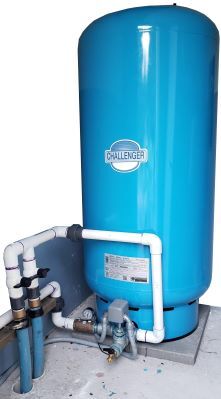Pressure Tanks
The purpose of a pressure tank is to store the water pressure that is produced by the pump and realease it as needed. Without a properly configured (or functioning) pressure tank, the pump would slam on and off each time someone used a small amount of water. This type of rapid pump cycling will significantly shorten the service life of the pump. If your pump runs for less than 1 to 2 minutes each time it turns on, there may be a problem with your pressure tank.

Captive Air Pressure Tank
Captive Air Pressure Tanks have a rubber diaphram, or balloon, that separates the water from the pre-pressurized air charge. The rubber separation between the air and the water effectively prevents the air from disolving into the water - hence the name, "Captive Air". Over time, the rubber separator can fail, allowing the air to escape and creating a "water logged" condition in which the tank does not function properly.
Captive Air Pressure Tanks should be checked by a pump contractor every few years to make sure that they are still charged with the appropriate air pressure, which must be in balance with other systems pressure settings.
You can do your own quick-check on your pressure tank by slapping it and listening to the sound. If it sounds like a water mellon (full of water) the diaphram has failed and it should be replaced. If it the sound has a bit of a "ring" to it, then it probably has not failed yet, but the presure should still be checked.

Standard Galvanized Pressure Tank
These galvanized pressure tanks are an older style, in which the air charge cushion is not separated from the water. Consequently, the air disolves into the water quickly and must be maintained by other water system components. If any of these other components fail, the galvanized pressure tank will be over or under charged with air - both of which can cause rapid pump cycling and shorten the service life of the pump. Constant diligence is required to keep these pressure tanks operating properly.
Give us a call if you have any questions or concerns about operation and maintenance of your pressure tank.

